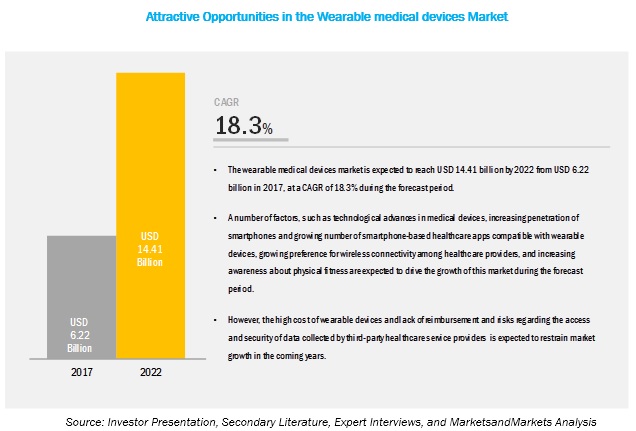Wearable Healthcare Devices Market : Market Size, Trends, Key Players and Forecast
According to research report Wearable Medical Devices Market size is projected to reach USD 46.6 billion by 2025 from USD 18.4 billion in 2020, at a CAGR of 20.5% from 2020 to 2025.
Wearable healthcare devices are autonomous devices that can be
attached, worn, or handheld for monitoring and examining the metabolic
& physiological changes that occur in the human body. These devices
are also used to record data. Wearable healthcare devices monitor and
diagnose many diseases such as sleep apnea, skin temperature, blood
glucose level, sleep patterns, general health parameters, fitness, and
wellness progress among athletes and fitness enthusiasts. These devices
are also used in various therapeutic applications such as pain
management, rehabilitative services, and respiratory care.
Download PDF Brochure: https://www.marketsandmarkets.com/pdfdownloadNew.asp?id=81753973
Based on device type, the wearable healthcare devices market is
segmented into diagnostic & monitoring devices and therapeutic
devices. In 2019, the diagnostic & monitoring devices segment
accounted for a larger share of 64.3% of themarket. The large share of
this segment can be attributed to factors such as the growing prevalence
of chronic & lifestyle diseases, the availability of
technologically advanced and compact products that can be easily worn,
the ability of diagnostic & monitoring devices to diagnose multiple
health conditions at relatively earlier stages, and the increasing
accuracy of the products.
Based on applications, the wearable
healthcare devices market is segmented into general health and fitness,
remote patient monitoring, and home healthcare applications. In 2019,
the general health and fitness segment accounted for the largest share
of the market, primarily due to the increasing focus on physical fitness
among people to improve their quality of life, coupled with the growing
trend of tracking health progress on a continuous basis.
Based
on the distribution channel, the wearable medical devices market is
segmented into pharmacies, online channels, and hypermarkets. Pharmacies
accounted for the largest share of 46.7% of the global wearable
healthcare devices market in 2019. The increasing trend of
self-monitoring and non-invasive monitoring and diagnosis has resulted
in a substantial increase in the supply of wearable devices in
pharmacies. This is driving the uptake of wearable devices among
customers, as they have easy access to various wearable devices offered
by a number of companies. Furthermore, pharmacies are widely perceived
to sell authentic and reliable products, which has greatly driven
consumer preference for this distribution channel.
The
prominent players operating in this market include Medtronic plc
(Ireland), OMRON Corporation (Japan), Koninklijke Philips N.V.
(Netherlands), and Apple Inc. (US). The other key players in this market
are Dexcom Inc. (US), BioTelemetry (US), Abbott Laboratories (US),
Bio-Beat Technologies Ltd (Israel), Masimo Corporation (US),
Minttihealth (China), CONTEC Medical Systems Co Ltd (China), Biotricity
Inc. (US), and iRhythm Technologies, Inc. (US). Players in this market
focused on partnerships, collaborations, agreements, acquisitions,
expansions, and product launches & approvals to develop and expand
their market presence between January 2017 and February 2020.
Apple, Inc. (US)
Apple is one of the largest players in the global wearable healthcare
devices market. The company’s leading position is attributed to its high
focus on innovation, strong product portfolio, and highly acclaimed
brand. The company focuses on regular product launches to increase its
market presence and share. For example, in 2019, the company launched
Apple Watch Series 5. In order to combat competition, Apple focuses on
continuous R&D to launch with new and upgraded products. It also
invests heavily in R&D; in 2019, the company invested USD 16.2
billion in R&D activities. Furthermore, Apple has a strong
geographical presence and is well complemented by its products
portfolio.
Fitbit, Inc. (US)
Fitbit
is a leading player in the global wearable medical devices market. The
company’s leading position is attributed to its high focus on innovation
and broad product portfolio. The company focuses on product launches in
order to increase its market presence. For instance, in 2019, the
company launched Fitbit Charge 4. It also places significant importance
on global expansion, which is evident from the firm’s expansion in Latin
American countries such as Argentina and Peru in 2019. Apart from this,
the company has a robust product portfolio with its offerings
compatible with both adults and children. It is also supported by its
strong distribution channel. Fitbit offers its products through 39,000
retail stores in 100 countries.
Request For Sample Pages: https://www.marketsandmarkets.com/requestsampleNew.asp?id=81753973
However, the Asia Pacific market is estimated to grow at the highest
CAGR during the forecast period. This can be attributed to the presence
of a large patient population, growing penetration of smartphones,
increasing disposable income, improving the standard of living &
economic conditions, and the presence of several low-cost device
manufacturers in the Asia Pacific.
Contact:
Mr. Aashish Mehra
MarketsandMarkets™ INC.
630 Dundee Road
Suite 430
Northbrook, IL 60062
USA: +1-888-600-6441
Email: sales@marketsandmarkets.com

Comments
Post a Comment